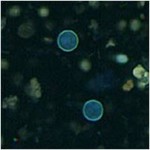
Anytime you or I feel particularly content with our achievements, we would be well advised to review the biography of Marie Curie. We would then quickly realize that we are unambitious mediocrities who should be much more productive. The magnitude of her accomplishments is dizzying. Virtually everything we know about radioactivity rests on the work of Madame Curie and her husband Pierre. The Curies coined the term radioactivity. She discovered the elements polonium and radium. She received two Nobel Prizes. Your last broken bone was diagnosed thanks to her pioneering work on x-rays.
This week’s news relates to Madame Curie’s discovery of radium-226 over a century ago. She even published a paper describing that tumor-forming cells were destroyed faster than healthy cells when exposed to radium. Radium emits alpha particles which are much more lethal to living cells than x-rays or gamma rays but penetrate living tissue less than a tenth of a millimeter. This would seem to be an ideal treatment for cancer if the radium could be transported to the tumor and not to healthy tissues. The insurmountable problem at Curie’s time was that radium-226 has a half-life of over a millennium and decays to radioactive radon gas, a substance you don’t want inside you.
Fast-forward to the present. Advanced cyclotrons now allow production and purification of specific isotopes that Madame Curie could only dream about, like radium-223. Radium-223 also emits alpha particles, but has a half-life of 11 days and decays to stable chemicals. That means that in a month only about an eighth of the original amount remains. Radium appears chemically to the human body a lot like calcium, so the body transports it rapidly to the bones, especially to areas where bone is being destroyed and rebuilt. Given the tiny tissue penetration of alpha rays, that would seem to be a perfect way to irradiate bone tumors.
This week the New England Journal of Medicine (NEJM) published the results of a fascinating study testing the effects of radium-223 in patients with metastatic prostate cancer in whom hormonal treatment had already failed. Patients with prostate cancer that has spread to the bone eventually develop bone pain which can be severe, and are at high risk for disabling fractures. Once their cancer stops responding to hormonal medicines, their life expectancy is about a year. That means these patients typically have both very little life expectancy and a miserable quality of life.
The study randomized over 900 such patients to receive intravenous injections of radium-233 or placebo every four weeks for six total doses. The primary endpoint measured was survival, but measures of quality of life like fractures and bone pain were also recorded. The patients given radium survived an average of 14 months, while those who received placebo survived an average of 11 months. That may not seem like a big difference, but I suspect it’s a huge difference to someone who has only 11 months to live. It’s also a very important difference because cancer treatments that prolong survival (rather than just shrink tumors) are notoriously difficult to find. The patients receiving radium also had fewer adverse events – like fractures – and had better quality of life. The radium did not cause serious side effects.
This is a very exciting finding, and not only for patients with advanced prostate cancer. It is the first time alpha rays have been used to treat disease. Given the excellent tolerability of radium-232 future trials should test it earlier in the course of metastatic prostate cancer. The treatment of other cancers that spread to bone should also be tested. Madame Curie would have been delighted by this advance, and would be quite impatient for us to get to the next discovery.
Learn more:
Radium-223 and Metastatic Prostate Cancer (Summary video from the editors of NEJM)
New Radiation Therapy Prolongs Prostate Cancer Survival (NY Times)
New Drug May Extend Survival for Some Prostate Cancer Patients (US News)
Fighting Prostate Cancer with Radium-223 — Not Your Madame’s Isotope (NEJM editorial)
Alpha Emitter Radium-223 and Survival in Metastatic Prostate Cancer (NEJM article)

